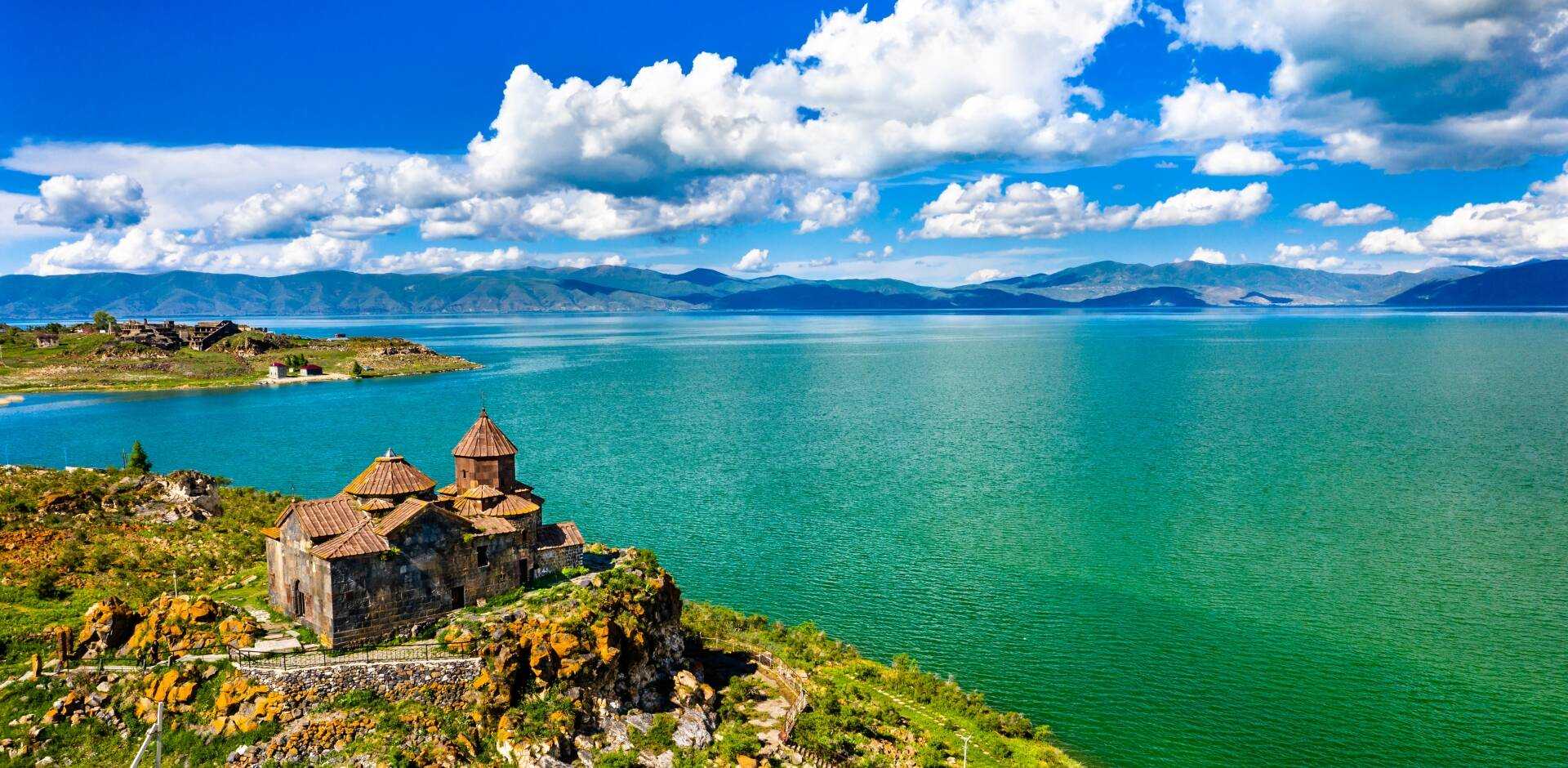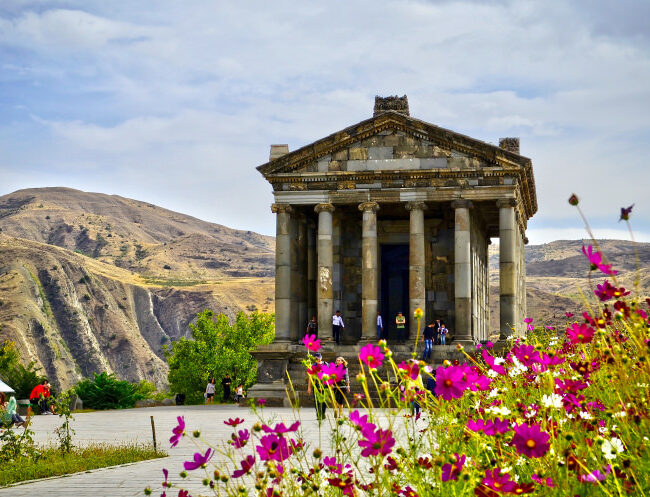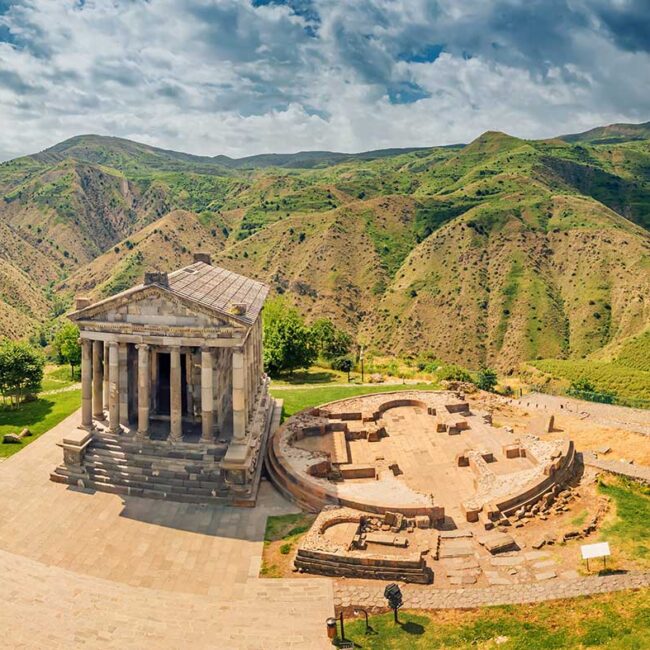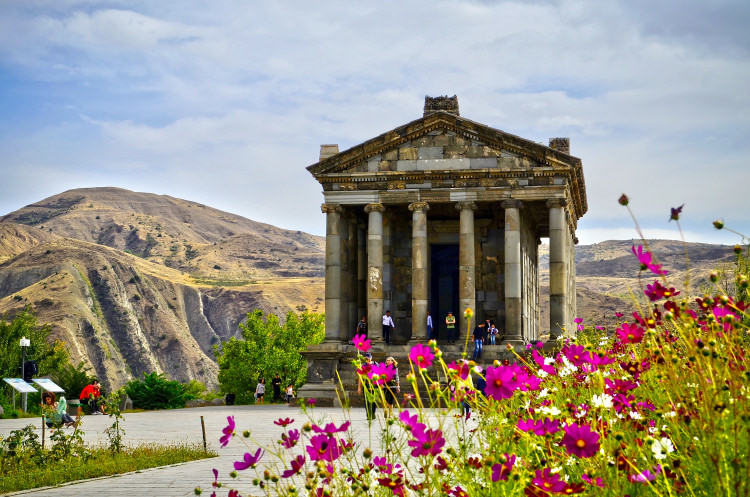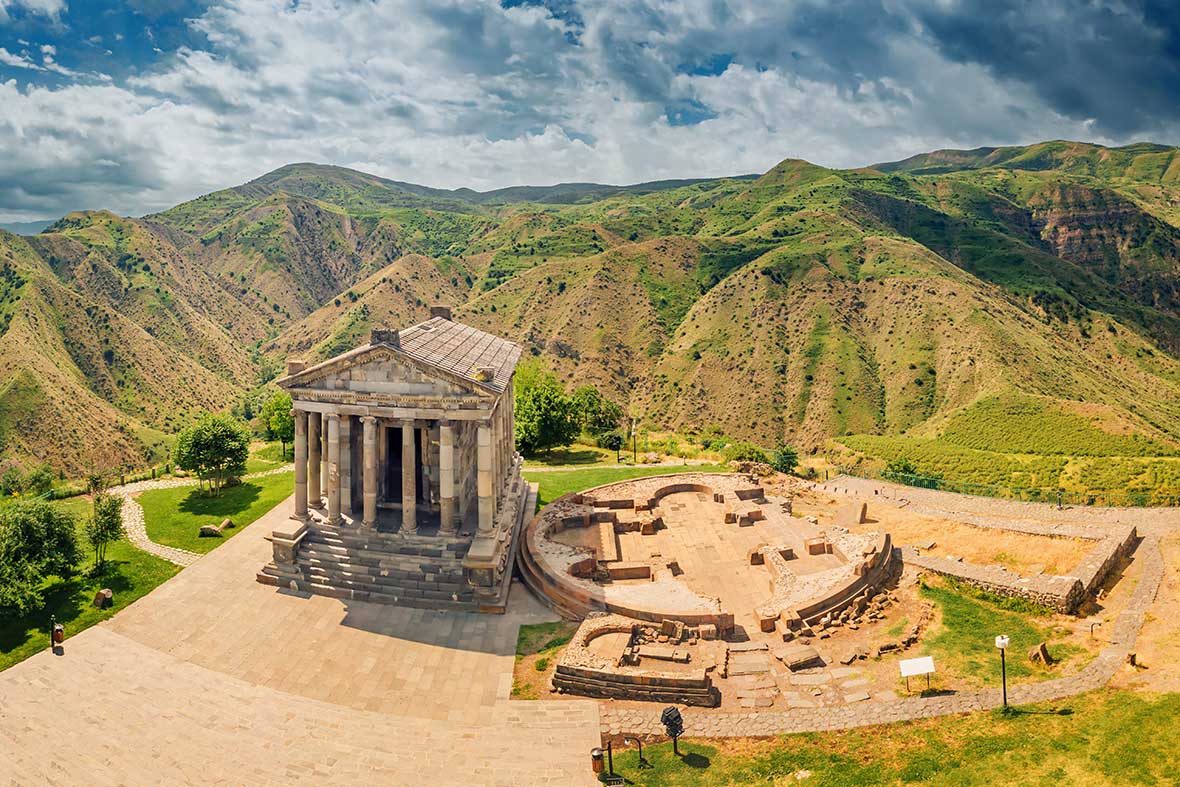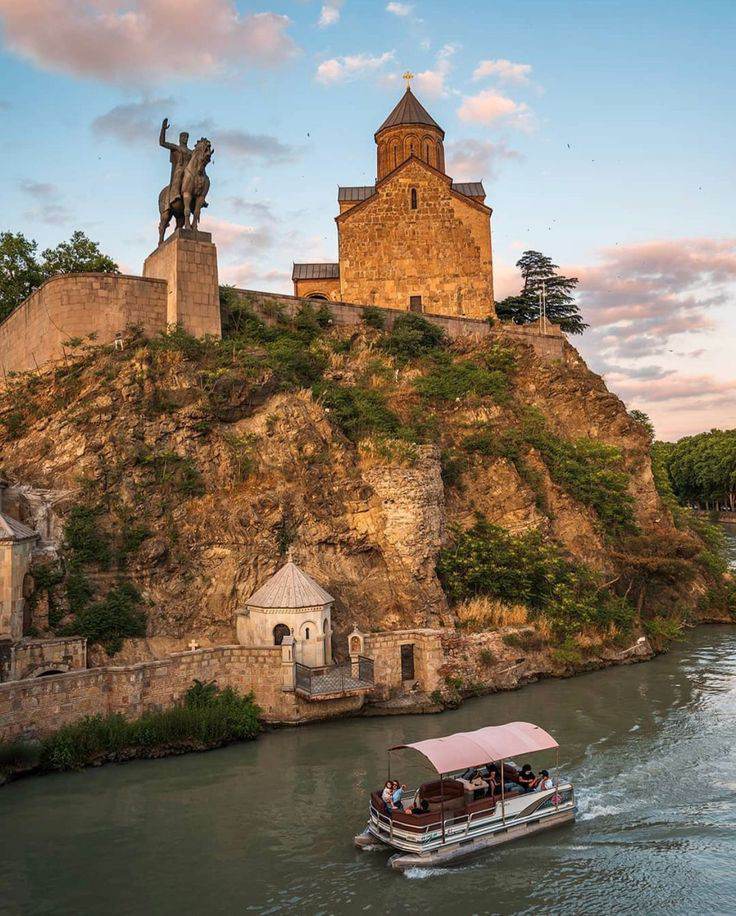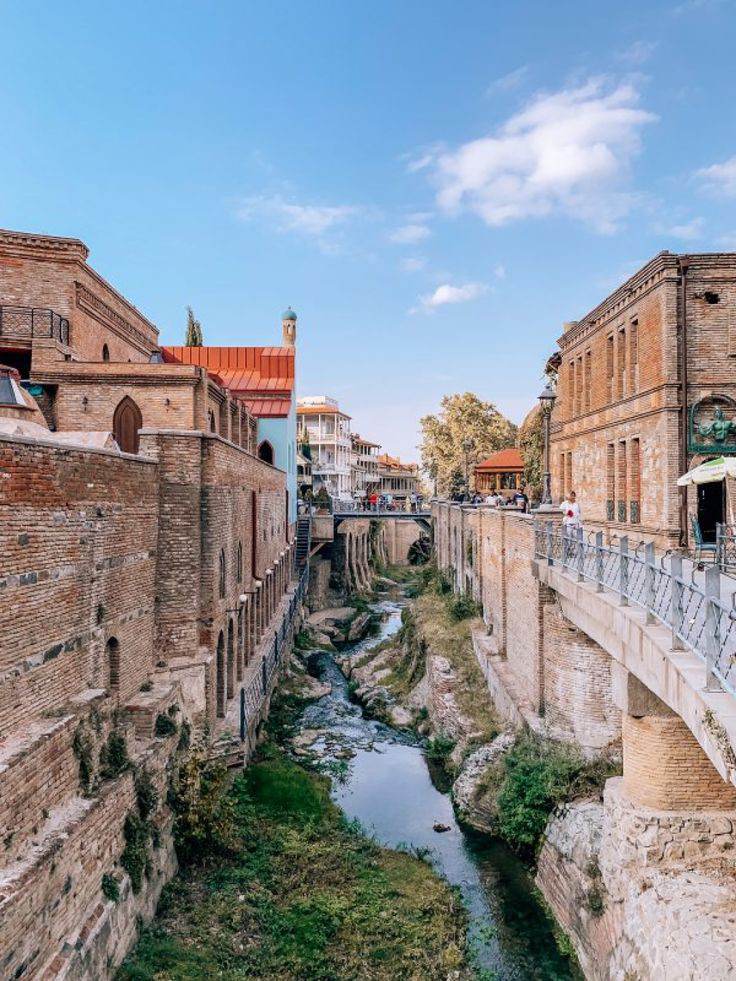Tour Around Georgia and Armenia from Kutaisi
€660
/ per person
(0 Reviews)
Price Include:
- Transfers from the Airport.
- Accommodation at 3* hotel during the tour – 7 nights.
- Comfortable 17-seat bus during the tour.
- Polish-speaking guide during the tour.
- Entrance tickets in museums.
- Meal: 7 Breakfasts and 7 dinners during the tour.
- 1 bottle of water per person daily.
Price Exclude:
- Air-tickets.
- Visa expenses on the border if needed.
- Lunches during the tour (10-15 Euros per person).
- Optional offers during the tour.
- Cable car tickets in Tatev (20 Euro per person).
- Tour leader for free.
Tour Plan
1
Day 1. Kutaisi - Tbilisi.
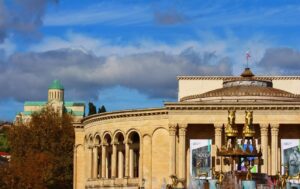 Arrival in Kutaisi.
Departure to Tbilisi.
Accommodation at the hotel.
Overnight in Tbilisi.
Arrival in Kutaisi.
Departure to Tbilisi.
Accommodation at the hotel.
Overnight in Tbilisi. 2
Day 2. Tbilisi city tour.
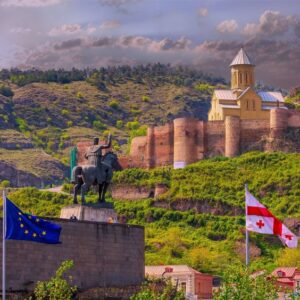 Breakfast. Tbilisi city tour.
During the tour, you will visit:
Narikhala Fortress – We will be traveling by cable cars from Rike Park to Narikala Fortress, which has existed since the mid-4th century. The fortress is built on a hill, therefore there is a splendid view of the old city.
District sulfur baths and Legvtahevi – are in the center of the city. Through the area Passes the rivulet of Legvtahevi. Her beautiful canyon was hidden for decades and has only been reconstructed - and returned to its historic appearance.
Meydan - the central square of the old town, which was formerly a commercial center of the city and nowadays is currently surrounded by cafe bars.
The Sharden area is full of narrow streets with cozy cafés, wine-tasting bars, and souvenir shops. Rezo Gabriadze Marionette Theater. Liberty Square, Rustaveli Avenue.
Departure to Armenia.
Visit Goshavank monastery in Armenia - Goshavank Monastery was the major medieval university used to be. Goshavank was erected in 1188 in the place of the ancient monastery Getik destroyed by the earthquake. The politician, outstanding scientist, and writer of medieval Armenia, Mkhitar Gosh, whose name was given to the monastery, took part in its construction.
Breakfast. Tbilisi city tour.
During the tour, you will visit:
Narikhala Fortress – We will be traveling by cable cars from Rike Park to Narikala Fortress, which has existed since the mid-4th century. The fortress is built on a hill, therefore there is a splendid view of the old city.
District sulfur baths and Legvtahevi – are in the center of the city. Through the area Passes the rivulet of Legvtahevi. Her beautiful canyon was hidden for decades and has only been reconstructed - and returned to its historic appearance.
Meydan - the central square of the old town, which was formerly a commercial center of the city and nowadays is currently surrounded by cafe bars.
The Sharden area is full of narrow streets with cozy cafés, wine-tasting bars, and souvenir shops. Rezo Gabriadze Marionette Theater. Liberty Square, Rustaveli Avenue.
Departure to Armenia.
Visit Goshavank monastery in Armenia - Goshavank Monastery was the major medieval university used to be. Goshavank was erected in 1188 in the place of the ancient monastery Getik destroyed by the earthquake. The politician, outstanding scientist, and writer of medieval Armenia, Mkhitar Gosh, whose name was given to the monastery, took part in its construction.
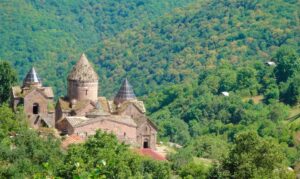 Departure to Dilijan - Dilijan is a town in northern Armenia. It's known for spa resorts and traditional craft workshops. The town is surrounded by the forests of Dilijan National Park. The Geological Museum and Art Gallery displays archaeological finds and international art.
Accommodation at the hotel.
Dinner at the hotel or nearby.
Overnight in Dilijan.
Departure to Dilijan - Dilijan is a town in northern Armenia. It's known for spa resorts and traditional craft workshops. The town is surrounded by the forests of Dilijan National Park. The Geological Museum and Art Gallery displays archaeological finds and international art.
Accommodation at the hotel.
Dinner at the hotel or nearby.
Overnight in Dilijan. 3
Day 3. Dilijan – Sevan lake - Yerevan.
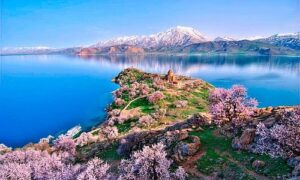 Breakfast. Departure to Sevan Lake.
On the way we will visit Sevani Lake - Lake Sevan is a large, high-altitude lake in eastern Armenia. Visit monastery Sevanavank - Sevanavank is a monastic complex located on a peninsula at the northwestern shore of Lake Sevan in the Gegharkunik Province of Armenia, not far from the town of Sevan.
Departure to Yerevan. City tour in Yerevan. During the tour, you will visit:
Armenian mother - Mother Armenia is a female personification of Armenia. Her most public visual rendering is a monumental statue in Victory Park overlooking the capital city of Yerevan, Armenia.
Yerevan Cascade - The Cascade is a giant stairway made of limestone in Yerevan, Armenia. It links the downtown Ketron area of Yerevan with the Monument neighborhood.
Designed by architects Jim Torosyan, Aslan Mkhitaryan, and Sargis Gurzadyan the construction of the cascade started in 1971 and was partially completed in 1980.
Opera and ballet theatre - Armenian National Academic Theatre of Opera and Ballet named after Alexander Spendiaryan in Yerevan was officially opened on 20 January 1933, with Alexander Spendiaryan's Almast opera performance. The opera building was designed by the Armenian architect Alexander Tamanian.
North Avenue - Northern Avenue is a pedestrian avenue in Yerevan,
Breakfast. Departure to Sevan Lake.
On the way we will visit Sevani Lake - Lake Sevan is a large, high-altitude lake in eastern Armenia. Visit monastery Sevanavank - Sevanavank is a monastic complex located on a peninsula at the northwestern shore of Lake Sevan in the Gegharkunik Province of Armenia, not far from the town of Sevan.
Departure to Yerevan. City tour in Yerevan. During the tour, you will visit:
Armenian mother - Mother Armenia is a female personification of Armenia. Her most public visual rendering is a monumental statue in Victory Park overlooking the capital city of Yerevan, Armenia.
Yerevan Cascade - The Cascade is a giant stairway made of limestone in Yerevan, Armenia. It links the downtown Ketron area of Yerevan with the Monument neighborhood.
Designed by architects Jim Torosyan, Aslan Mkhitaryan, and Sargis Gurzadyan the construction of the cascade started in 1971 and was partially completed in 1980.
Opera and ballet theatre - Armenian National Academic Theatre of Opera and Ballet named after Alexander Spendiaryan in Yerevan was officially opened on 20 January 1933, with Alexander Spendiaryan's Almast opera performance. The opera building was designed by the Armenian architect Alexander Tamanian.
North Avenue - Northern Avenue is a pedestrian avenue in Yerevan,
 Armenia opened in 2007 Republic Square - Republic Square is the central town square in Yerevan, the capital of Armenia. The Armenian Genocide Memorial – Tsitsernakaberd - The Armenian
Genocide Memorial Complex is Armenia's official memorial dedicated to the victims of the Armenian Genocide, built in 1967 on the hill of Tsitsernakaberd in Yerevan.
Accommodation at the hotel.
Dinner at the hotel or nearby.
Overnight in Yerevan.
Armenia opened in 2007 Republic Square - Republic Square is the central town square in Yerevan, the capital of Armenia. The Armenian Genocide Memorial – Tsitsernakaberd - The Armenian
Genocide Memorial Complex is Armenia's official memorial dedicated to the victims of the Armenian Genocide, built in 1967 on the hill of Tsitsernakaberd in Yerevan.
Accommodation at the hotel.
Dinner at the hotel or nearby.
Overnight in Yerevan.
4
Day 4. Yerevan – Geghard – Temple of Garny – Yerevan.
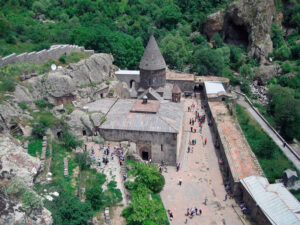 Breakfast. Departure to the Geghard monastery - The monastery of Geghard and the Upper Azat Valley contains several churches and tombs, most of them cut into the living rock, which illustrates Armenian medieval architecture at its highest point.
The complex of medieval buildings is set into a landscape of great natural beauty, at the entrance to the Azat Valley. High cliffs from the northern side surround the complex while the defensive wall encircles the rest. The monuments included in the property are dated from the 4th to the 13th century. In the early period, the Monastery was called Ayrivank (Monastery in the Cave) because of its rock-cut construction.
Visit the Temple of Garni – this is the only standing Greco-Roman colonnaded building in
Breakfast. Departure to the Geghard monastery - The monastery of Geghard and the Upper Azat Valley contains several churches and tombs, most of them cut into the living rock, which illustrates Armenian medieval architecture at its highest point.
The complex of medieval buildings is set into a landscape of great natural beauty, at the entrance to the Azat Valley. High cliffs from the northern side surround the complex while the defensive wall encircles the rest. The monuments included in the property are dated from the 4th to the 13th century. In the early period, the Monastery was called Ayrivank (Monastery in the Cave) because of its rock-cut construction.
Visit the Temple of Garni – this is the only standing Greco-Roman colonnaded building in 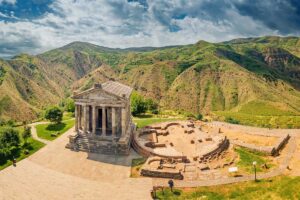 Armenia and the former Soviet Union. AnIonic pagan temple located in the village of Garni, Armenia, it is the best-known structure and symbol of pre-Christian Armenia. Optional offer: visit Stone Symphony (drive by Jeep 5 km.) (7 EURO)
Optional offer: Lunch and masterclass of making Armenian bread (15 Euro per person)
Optional offer: Masterclasses of carpet making, dried fruit making, pottery, and woodworking in Garni - (the price of each master class will be 10 Euro per person).
Drive back to Yerevan. Dinner at the hotel or nearby. Overnight in Yerevan.
Armenia and the former Soviet Union. AnIonic pagan temple located in the village of Garni, Armenia, it is the best-known structure and symbol of pre-Christian Armenia. Optional offer: visit Stone Symphony (drive by Jeep 5 km.) (7 EURO)
Optional offer: Lunch and masterclass of making Armenian bread (15 Euro per person)
Optional offer: Masterclasses of carpet making, dried fruit making, pottery, and woodworking in Garni - (the price of each master class will be 10 Euro per person).
Drive back to Yerevan. Dinner at the hotel or nearby. Overnight in Yerevan. 5
Day 5. Yerevan - Noravak Monastery - Tatev.
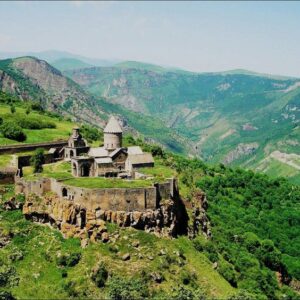 Breakfast. Departure to Tatev.
Optional offer: Visit the wine factory on the way for the degustation of Armenian wine with some snacks (10-15 Euro per person).
Visit Noravank monastery on the way to Tatev- The Monastery of Noravank – the pearl of Armenian medieval architecture – is one of the most admired shrines in the country.
The monastery complex is located 10 km south of the village of Areni, in the Vayots Dzor region, in the picturesque gorge of the Amaghu River. Noravank monastery was founded by Bishop Hovhannes in 1105, and in the 13-14 centuries, thanks to the ruling Orbelian family, Noravank flourished and became the spiritual, educational, and cultural center of Syunik province. The complex consists of two chapels and three churches: St. Karapet, St. Stepanos the Precursor, and the Holy Mother of God. In 2002 Noravank Monastery was included in the UNESCO World Cultural Heritage list.
Departure to Tatev.
Visit Monastery by cable car- Tatev Monastery is a 9th-century historical monument. It is one of the oldest and most famous monastery complexes in Armenia. During medieval times Tatev Monastery was a vital scholastic, enlightenment, and spiritual center and played a
Breakfast. Departure to Tatev.
Optional offer: Visit the wine factory on the way for the degustation of Armenian wine with some snacks (10-15 Euro per person).
Visit Noravank monastery on the way to Tatev- The Monastery of Noravank – the pearl of Armenian medieval architecture – is one of the most admired shrines in the country.
The monastery complex is located 10 km south of the village of Areni, in the Vayots Dzor region, in the picturesque gorge of the Amaghu River. Noravank monastery was founded by Bishop Hovhannes in 1105, and in the 13-14 centuries, thanks to the ruling Orbelian family, Noravank flourished and became the spiritual, educational, and cultural center of Syunik province. The complex consists of two chapels and three churches: St. Karapet, St. Stepanos the Precursor, and the Holy Mother of God. In 2002 Noravank Monastery was included in the UNESCO World Cultural Heritage list.
Departure to Tatev.
Visit Monastery by cable car- Tatev Monastery is a 9th-century historical monument. It is one of the oldest and most famous monastery complexes in Armenia. During medieval times Tatev Monastery was a vital scholastic, enlightenment, and spiritual center and played a 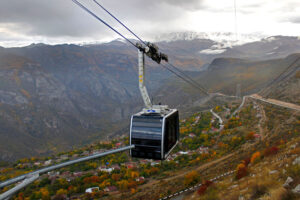 singular role in the country’s history. Restoration of the monastery, re-establishing its educational legacy, and reviving monastic life at Tatev is one of the main goals of the Tatev Revival Program, a part of which is the Wings of Tatev aerial tramway. The term "Tatev" usually refers to the monastery. The monastic ensemble stands on the edge of a deep gorge of the Vorotan River. Accommodation at the Hotel.
Dinner at the hotel or nearby.
Overnight in Tatev/Goris.
singular role in the country’s history. Restoration of the monastery, re-establishing its educational legacy, and reviving monastic life at Tatev is one of the main goals of the Tatev Revival Program, a part of which is the Wings of Tatev aerial tramway. The term "Tatev" usually refers to the monastery. The monastic ensemble stands on the edge of a deep gorge of the Vorotan River. Accommodation at the Hotel.
Dinner at the hotel or nearby.
Overnight in Tatev/Goris. 6
Day 6. Tatev – Khor virap monastery - Yerevan.
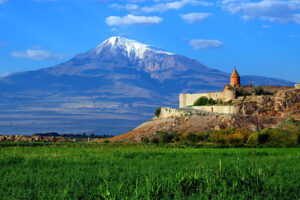 Breakfast. Departure to Khor Virap.
Visit Khor Virap - The Khor Virap is an Armenian monastery located in the Ararat plain in Armenia, near the closed border with Turkey, about 8 kilometers south of Artashat, Ararat Province, within the territory of ancient Artaxata. The monastery was host to a theological seminary and was the residence of Armenian Catholicos.
Departure to Yerevan.
Accommodation at the hotel.
Dinner at the hotel or nearby.
Overnight in Yerevan.
Breakfast. Departure to Khor Virap.
Visit Khor Virap - The Khor Virap is an Armenian monastery located in the Ararat plain in Armenia, near the closed border with Turkey, about 8 kilometers south of Artashat, Ararat Province, within the territory of ancient Artaxata. The monastery was host to a theological seminary and was the residence of Armenian Catholicos.
Departure to Yerevan.
Accommodation at the hotel.
Dinner at the hotel or nearby.
Overnight in Yerevan. 7
Day 7. Yerevan – Echmiadzin - Bavra border - Vardzia.
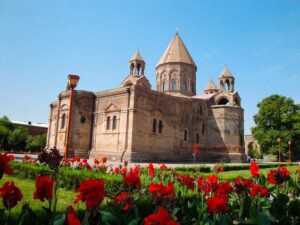 Breakfast.
Optional offer: Visit Cognac factory for degustation of Armenian brand (15 Euro per person)
Departure to Vagharshapat.
Visit Echmiadzin, which means «The Descent of the Only Begotten Son» is an ancient capital of Armenia. According to legend, Jesus Christ descended from heaven and indicated the spot for a church to be built. Holy Echmiadzin Cathedral was erected at that site in the 4th century (301-303), at the dawn of the Christian conversion of the country by King Trdat III and Saint Gregory the Illuminator.
Zvartnots, a complex of structures erected in the middle of the 7th century near Ejmiatsin, is of extreme architectural value. The complex consisted of St. George temple or Zvartnots and the palace of Katholikos Nerses Ill, known as «Builder». Zvartnots, built as Armenia's main cathedral in 641—661, was to suppress the Ejmiatsin cathedral by its grandeur. This purpose was served by the original architectural composition of the building which is an example of a central-dome temple different in its appearance from the antique and
Breakfast.
Optional offer: Visit Cognac factory for degustation of Armenian brand (15 Euro per person)
Departure to Vagharshapat.
Visit Echmiadzin, which means «The Descent of the Only Begotten Son» is an ancient capital of Armenia. According to legend, Jesus Christ descended from heaven and indicated the spot for a church to be built. Holy Echmiadzin Cathedral was erected at that site in the 4th century (301-303), at the dawn of the Christian conversion of the country by King Trdat III and Saint Gregory the Illuminator.
Zvartnots, a complex of structures erected in the middle of the 7th century near Ejmiatsin, is of extreme architectural value. The complex consisted of St. George temple or Zvartnots and the palace of Katholikos Nerses Ill, known as «Builder». Zvartnots, built as Armenia's main cathedral in 641—661, was to suppress the Ejmiatsin cathedral by its grandeur. This purpose was served by the original architectural composition of the building which is an example of a central-dome temple different in its appearance from the antique and 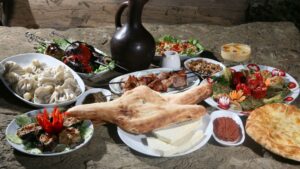 Byzantine structures of this kind.
Departure to Georgia (Bavra border).
After border control Departure to Vardzia. Accommodation at the hotel.
Optional offer: Masterclass of making Georgian bread/Khinkali/Khachapuri - (the price of each master class will be 15 Euro per person) Dinner at the hotel or nearby
Overnight in Vardzia.
Byzantine structures of this kind.
Departure to Georgia (Bavra border).
After border control Departure to Vardzia. Accommodation at the hotel.
Optional offer: Masterclass of making Georgian bread/Khinkali/Khachapuri - (the price of each master class will be 15 Euro per person) Dinner at the hotel or nearby
Overnight in Vardzia. 8
Day 8. Vardzia - Kutaisi.
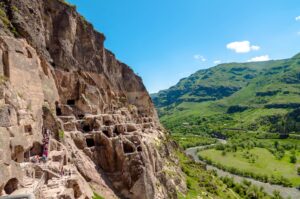 Breakfast.
Visit Vardzia cave monastery - Vardzia is a cave monastery site in southern Georgia, excavated from the slopes of the Erusheti Mountain on the left bank of the Kura River. The main period of construction was the second half of the twelfth century.
Departure to Kutaisi.
Optional offer: Visit the winery for a Degustation of Georgian wine (10 Euro per person).
Free time. Dinner. Transfer to the airport. Flight from Kutaisi.
Breakfast.
Visit Vardzia cave monastery - Vardzia is a cave monastery site in southern Georgia, excavated from the slopes of the Erusheti Mountain on the left bank of the Kura River. The main period of construction was the second half of the twelfth century.
Departure to Kutaisi.
Optional offer: Visit the winery for a Degustation of Georgian wine (10 Euro per person).
Free time. Dinner. Transfer to the airport. Flight from Kutaisi. 

